Belated musings on the making of history
The kind that I'll actually remember, anyway. On stages 19-21 of the Giro...
All image credits: you guessed it - terrible phone camera snaps of my laptop screen!
Ever had that feeling, where you just do not know where to start? Yeah, that. That’s me, now, sitting down to try and piece together a Substack post that’s supposed to round up the final three stages of the Giro d’Italia. It feels a bit like arriving at a really cool party, but you’ve mixed up the times and you were supposed to arrive three hours ago. And now everyone’s drunk and the food has run out and your mates are all giggling about something that happened before you got there.
Reactions to a big sporting occasion which stand the test of time take two main forms, it seems: there are the immediate reactions coloured by emotion, spilled out in the moment, unfiltered and raw. You know the kind I mean: ‘they think it’s all over…it is now!’ That sort of thing.
Then there are the lyrical retrospectives, that take you back to the time and place, painted richly with a backdrop of colour, atmosphere and beautiful writing, rendering the actual date at which the race took place irrelevant – they are writing the event into history. It’s usually a great book, written several years if not decades after the event, and you’re learning about the fabric of the event, not just the cold hard facts of who won and who lost.
Everything in between slips between the gaps; race reports and post-race analysis quickly side-lined into the margins of the regular business of the season as it churns inexorably onward, brushing aside the momentous along with the mundane as professional sport and all its accoutrements necessarily must. For the athletes: the next training camp. The next race. The next goal. For the writers: the next preview. The next report, which inevitably fails to address everything that said preview failed to predict.
Reflection at the end of a season somehow doesn’t seem to quite cut it either, as everyone takes time away to regroup and allow their minds to gently unpick themselves from the stitching that’s sewn them into the season like an inside pocket in a winter coat. For an end of season retrospective to be worth its salt you need to slap a hard red cover on it and bind it for posterity so it can stand proudly on bookshelves, earning its right to belong alongside those aforementioned books, rather than be lost to the ravages of an algorithm online (let’s say, the Road Book).
Anyway, that’s a long and roundabout way of saying, I’m not sure where my summary of the final three stages will fit in the grand scheme of things, if anywhere. It is painfully late, and to cap off what was already a very busy week last week, I was in attendance at an actual, bona fide, real life bike race, spending two busy days at the Tour of Britain Women. More on that later. Or most likely another post.
Despite all of the reasons not to bother, I am nothing if not a lover of completeness, and while I’m quite bad at actually finishing tasks that need doing in other areas of my life, for some reason when it comes to summarising the goings-on at bike races, I’m grimly committed to the cause. So here I present, some things I can remember about the final three stages of the Giro d’Italia.
Stage 19. I’m going to level with you. I still haven’t watched stage 19.
I KNOW! I can hear you all yelling at me from here. WHAT KIND OF CYCLING OBSESSIVE EVEN ARE YOU?! And to make matters worse, a Frenchman won, on the first of two final decisive days in the mountains. It was the one ray of light for the French in on otherwise rather torrid three weeks, as Nicolas Prodhomme followed up his first pro win the Tour of the Alps a month prior with another, even bigger win.
Don’t worry though, I have prepared a list of excuses as to why I didn’t see the stage, which I will present to you now:
Reasons why I missed a Grand Tour stage for the first time in 5 years:
1. My 9-year-old son injured his finger in a light sabre battle (waged with massive sticks) at a friend’s house the day before. It went black and swelled up overnight and I genuinely thought it might be broken so took him to a walk-in centre for an x-ray. It was not broken. I was probably more bothered about it than he was. By that point, I was already two hours behind on the stage…
2. And I had agreed to take my 11-year-old daughter and her two friends for their first girlie shopping centre trip. I arrived, sent them off to spend money on stationery they didn’t need (like mother like daughter) and installed myself in Starbucks (not my preference of coffee shop but I’m allergic to massive shopping centres and it was the first one I found and it had seats), planning to catch up on the race. But the internet was painfully slow, so I wrote instead.
3. Planned on trying to get up to date with the race when I got home, but there was bomb scare on the estate where my daughters’ friends live, so they had to come back to our house while their parents worked out what to do following the evacuation (I kid you not. Thankfully it turned out to be a fake grenade and everyone got home safely later that evening).
4. In amongst all that panic, I had to prep for a night out that had been almost a year in the planning, which included getting myself ready and sorting out stuff for my kids to go stay at my mum’s house overnight.
5. Then I went out, and had fun, and got home late, and then, well, Saturday was stage 20, and that’s an excuse all by itself.
Is that good enough? Do I get a pass?
The heart of the matter is that life happens: it happens when you’re out riding a Grand Tour, and it happens when you’re just a fan, watching from home, trying to keep up with the chaos of family life in the school holidays while following an all-consuming bike race. Like I mentioned at the start, just as the cycling world moves inexorably forward, onto the next race, life doesn’t stop for hapless writers to sit down at their desks and catch up on a five-hour stage of a race that finished eight days ago. I just won’t get around to watching it. Can you imagine if it had been Romain Bardet who had won? Okay, maybe then I would have found the time.
The right kind of history
Stage 20 would be the final reckoning. One day to decide the outcome of a three-week bike race. Very rarely does a Grand Tour come down to its final (competitive) stage these days, or in fact historically, with matters often being wrapped up early, sometimes even with time to spare to tie a big, pink bow on it (or yellow, or red, depending on the Grand Tour). The fact that the final outcome wasn’t decided was exciting in itself – but the fact that it was three key players being involved in the final reckoning rather than just two, would be the added dimension that would ultimately define this as one of the most memorable days in cycling history.
That, and the weight of history itself. Lord help me - history! If there’s a word that is thrown around casually by commentators and sports writers alike with wanton disregard these days, it’s that one. History. Modern sport is breaking records and blazing trails left right and centre, as it necessarily should, what with the advancements in technology and equipment (at least in the kinds of sports where these things count) and cycling is currently mired in a period so replete with generational talent, on top of all that improvement, that history is made seemingly on a day-to-day basis. It’s frankly dizzying at times.
This was a different kind of history. The kind I actually value being around for, rather than the ‘beat you over the head with it, why are you complaining, what a time to be alive!’ type. The actual ‘story’ in the word ‘history’ came into play, beyond mere statistics - the story of Simon Yates: a quiet rider, with a chequered past when it comes to the kind of success he has achieved, compared with that which he couldn’t. Making history doesn’t have to be about smashing speed records, or blitzing your way through a Grand Tour raking in accolades and stage victories and wearing the jersey for as long as possible. It can just be about vanquishing personal demons, and delivering a day on the bike that will have people talking about it around a pint in the pub for many years to come. That’s what I’m came for, when I became a card-carrying member of the pro cycling fanatics club.
Of course, by now you will have heard the background story, if you didn’t know it already – Simon Yates, conquering the Colle delle Finestre, to win the Giro d’Italia, and in doing so, reversing the heartbreak that he endured seven years previously at the hands of his countryman Chris Froome, who raced up the same mountain, dropping Yates so hard he would be forced to relinquish the race lead he had guarded for 12 stages, having been beaten by an astonishing 38:51 minutes, on the day.
Such a capitulation wasn’t quite what we witnessed on the mountain this year – when Simon Yates attacked, it was far from ‘thermo-nuclear’ as the cycling influencers like to call it – not the dropped bomb that the likes of Pogačar are able to detonate, as behind him his rivals stare helplessly at his diminishing form as it disappears up the road ahead of them.
Not that, no. Something far more measured, and understated. Calculated, you could say. Reflective of Yates’ race to that point, one in which he had mostly sat back and allowed others to do the flamboyant attacks, preferring to follow wheels, and keep himself in contention, with the lowest possible expenditure of energy. He had learned perhaps, from past mistakes, and also maybe, from his new environment – a traditional GC team, Visma-Lease a Bike are usually the team who follow, protect, measure, and calculate, rather than explode races willy-nilly (Jonas’ ITT in 2022 perhaps, aside). It has proven to be a winning formula on many previous occasions.
So, there was Yates, pushing on up the Colle that had defeated him seven years earlier. Behind, the two protagonists of the race thus far – at least in the sense that they had been the ones to animate, to force action and demand reaction – the current race leader Isaac Del Toro and the most combative rider of them all, Richard Carapaz, whose EF team had ridden a frenetic tempo to explode the race earlier on in the day.
Yates and his pursuers were locked in a scenario which remained largely unchanged for the first few kilometres of climbing: with the distance between them attributable to the power Yates had injected in his first attack, and nothing more, give or take a second – literally, as the chasing pair would give, or take a second or two here and there – for a while then, it was speculative, Yates’ attack. Barely even an ‘attack’ really. They remained banded together yet separated by a not insurmountable distance and sitting at home, I remarked on how fateful it would be if Yates somehow were to win, and overcome his demons. Even then, I didn’t really believe it was possible.
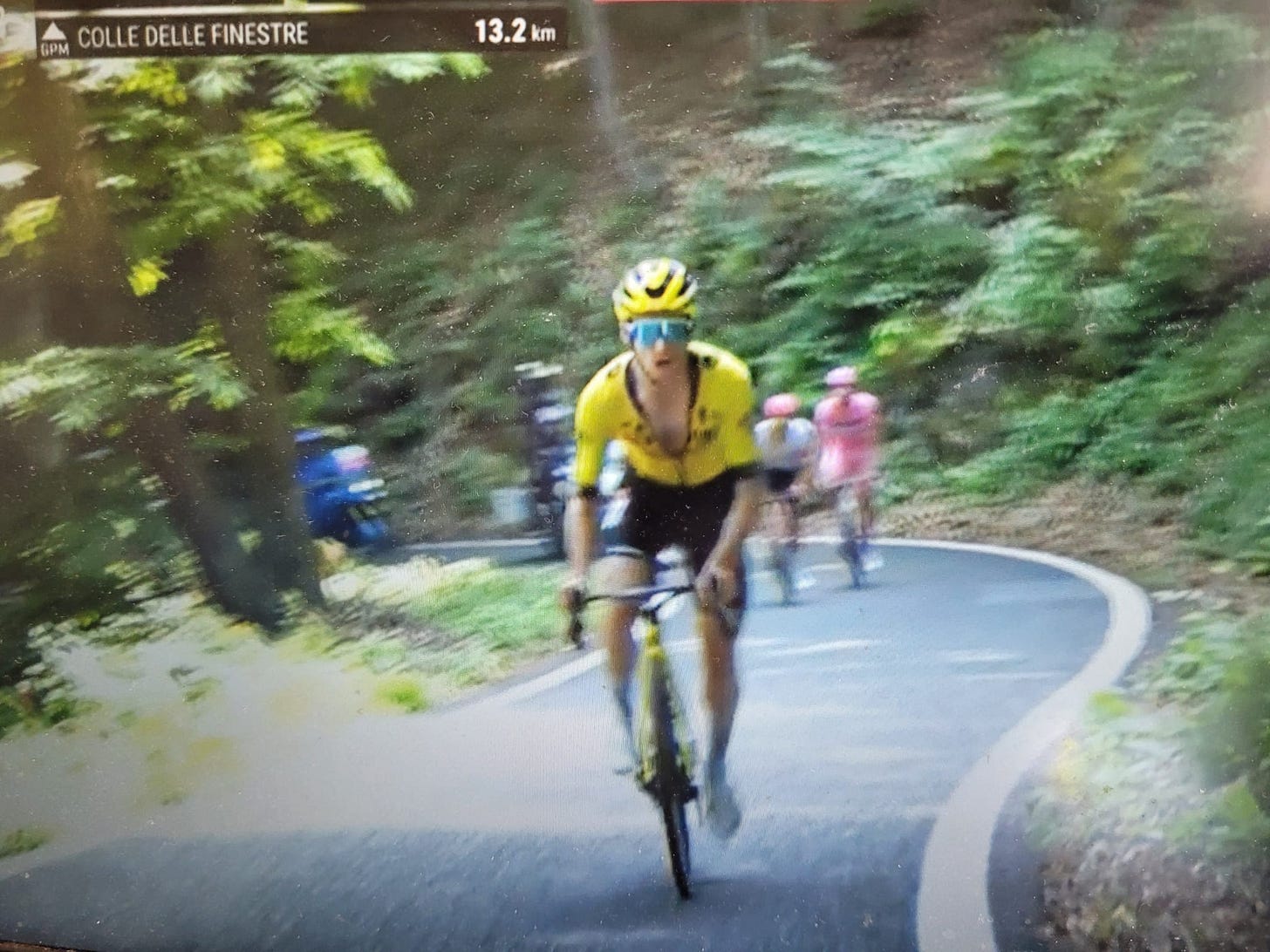
The gap began to build, after that, bit by bit, until we were scrambling to work out what was actually needed here, remembering Yates’ deficit prior to the stage, and the time ‘1:20’ became branded in my brain as I stared at the gap, willing him to do it, as he edged closer and closer to that magic advantage that he needed. Then past it. Still though, the result hung in the balance. The tension was unbearable, as the slow-motion drama played out minute by agonising minute in front of us.
The forgotten player, at this stage, was Wout van Aert. Two stories played out on the mountain that day, for Visma, and one of them remains untold, save for a few quotes in the media. There was no camera to watch the resurgent Van Aert, who had battled through a difficult first week at the race, after a tough spring Classics block, to take a stunning stage victory in Siena, as he set about putting in what must be deemed one of the climbing performances of his career. It’s criminal that we didn’t get to see him on that climb – it brought to mind the similar job he did for Jonas Vingegaard, on Hautacam in 2022, and once again reminded anyone who had begun to doubt him exactly who Wout van Aert is: quality bike rider; killer all-rounder; absolute workhorse of a teammate; thoroughly decent human. Worth his Wout in gold. (See what I did there?)
The rest, well. You know it by now. Whether Wout was the difference maker in the end, or merely a failsafe – the final reassurance for Yates as he made his way to the finish line knowing he had the race won – or whether it was down to the (half) Mexican stand-off going on further down the hill between Richard Carapaz and Isaac Del Toro – well, I would say we’ll never know, but either way, there was a beautiful moment when Yates had reached one of the highest points on the Finestre and could look over his shoulder, down the switchbacks below him, surveying the twists and turns of road that he had already conquered, to see his two rivals, far enough in arrears – with him as close as he was to the summit – to assure himself that short of a miracle or a disaster, he was going home in pink. That was the moment that made me smile the most. That, or the ensuing game of ‘where’s Wout?’, as Yates barrelled down the descent and we all wondered whether he’d climbed off his bike and gone for an impromptu picnic – I was already reeling at what I was seeing and there was a kind of deranged glee in knowing Wout would come into view at some point, having done something obscenely brilliant in the interim, and seamlessly deliver his leader to glory. When Yates finally did spy the significant Belgian up ahead there must have been a moment when he thought ‘bloody hell Wout, hurry up’ as he was moving a fair amount faster – but Wout got up to speed, and all was well.
As for Carapaz and Del Toro, for one it was the ultimate in gamesmanship – the absolute epitome of ‘if you’re going down, I’m taking you with me’, while for the other, it was probably a case of simply not having enough left in the tank, and tiring of the games.
Finally, there is the forgotten man. How many times have we seen this, over the years? A huge, dramatic, sweeping mountain stage, won by a breakaway rider not involved in the GC battle, their story lost in the furore that surrounds the leader - especially in circumstances such as those that transpired on that day. It’s exacerbated further when the man in question is such an understated, quiet character. Someone who has for so long worked in service of others. Finding a new home with his compatriots at Jayco-AlUla, Chris Harper has been given leadership, freed to go for lofty goals, and there are none greater than this. He rewarded their faith by not only taking the cima coppi prize, but winning the queen stage of the Giro d’Italia. Largely flying under the radar, even neglected by the director for large portions of the broadcast, as the drama that was unfolding behind admittedly warranted our full attention. Chapeau that man.
Stage 21 in Rome began with the culmination of a series of events which sum up the surreality of cycling as a professional sport. The whole peloton, in Saint Peter’s Square, arrayed around the Pope himself, as he was presented with a maglia rosa. The four special jersey wearers posed for photos with the pontiff, before he had an impromptu audience with Nairo Quintana (which made me wonder exactly who had to book time with who), and the race was subsequently blessed and sent on its way.
I’m not going to write anything about stage 21, other than to acknowledge that it was a great finish for the team who transformed their season at this race: from the doldrums in the Classics, to glory in the first Grand Tour of the season, Visma-Lease a Bike demonstrated their class in Italy with one final expert lead-out from Wout van Aert, who just one day prior had put in the climb of his life to set up Simon Yates for GC victory. He won a stage, was a crack lead-out man, and an elite climbing domestique, and surely for the man from Herentals, this is what relief must feel like. He was back to joking and smiling, and admitted that he was ‘close’ to being back to his best – to my mind, that equals one thing for UAE Team Emirates-XRG – trouble.
So… will that suffice? Since the race concluded, I’ve summarised some of my general thoughts about the race in a post I wrote for Domestique, which I hope you’ll enjoy (check out the platform while you are there – I’m a little biased, but I think it’s excellent). And then we all moved on… I went to the Tour of Britain (impressions from that will be in my next post), and the Critérium du Dauphiné has begun, and we are officially on the countdown to the Tour de France. Which begins in *checks calendar* three-and-a-half weeks.
Excuse me, while I take myself off for a lie down in a darkened room.
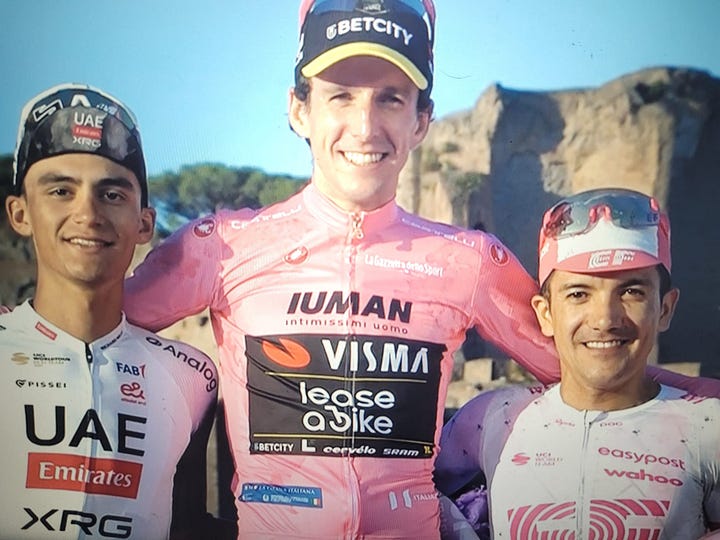
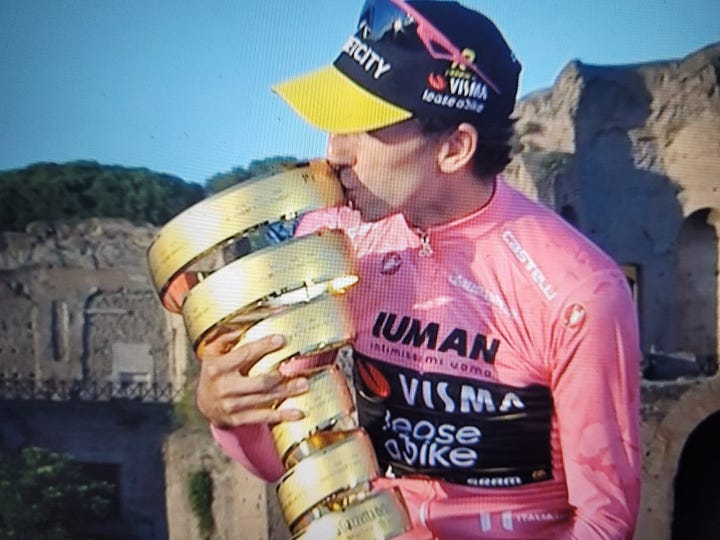



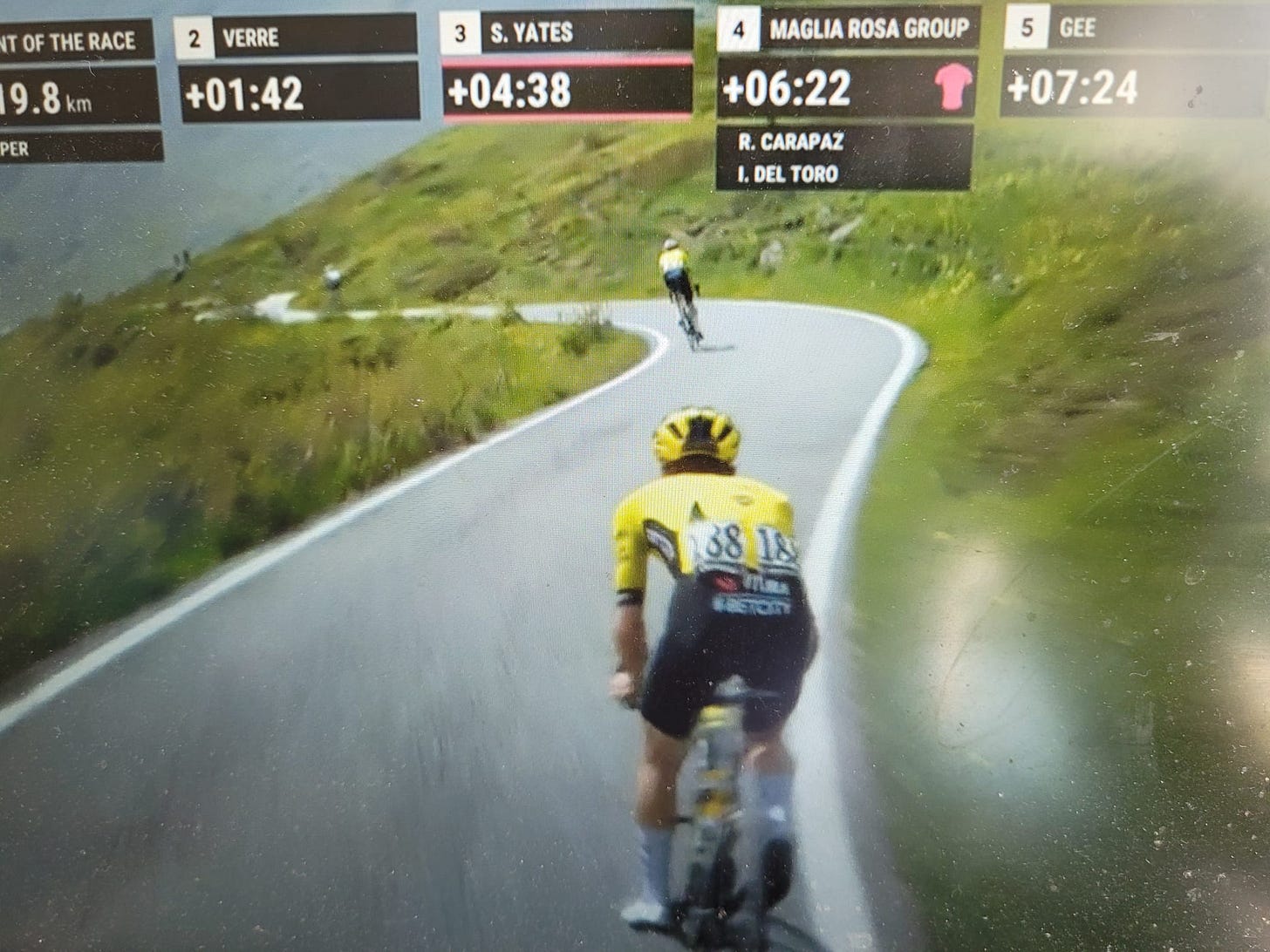
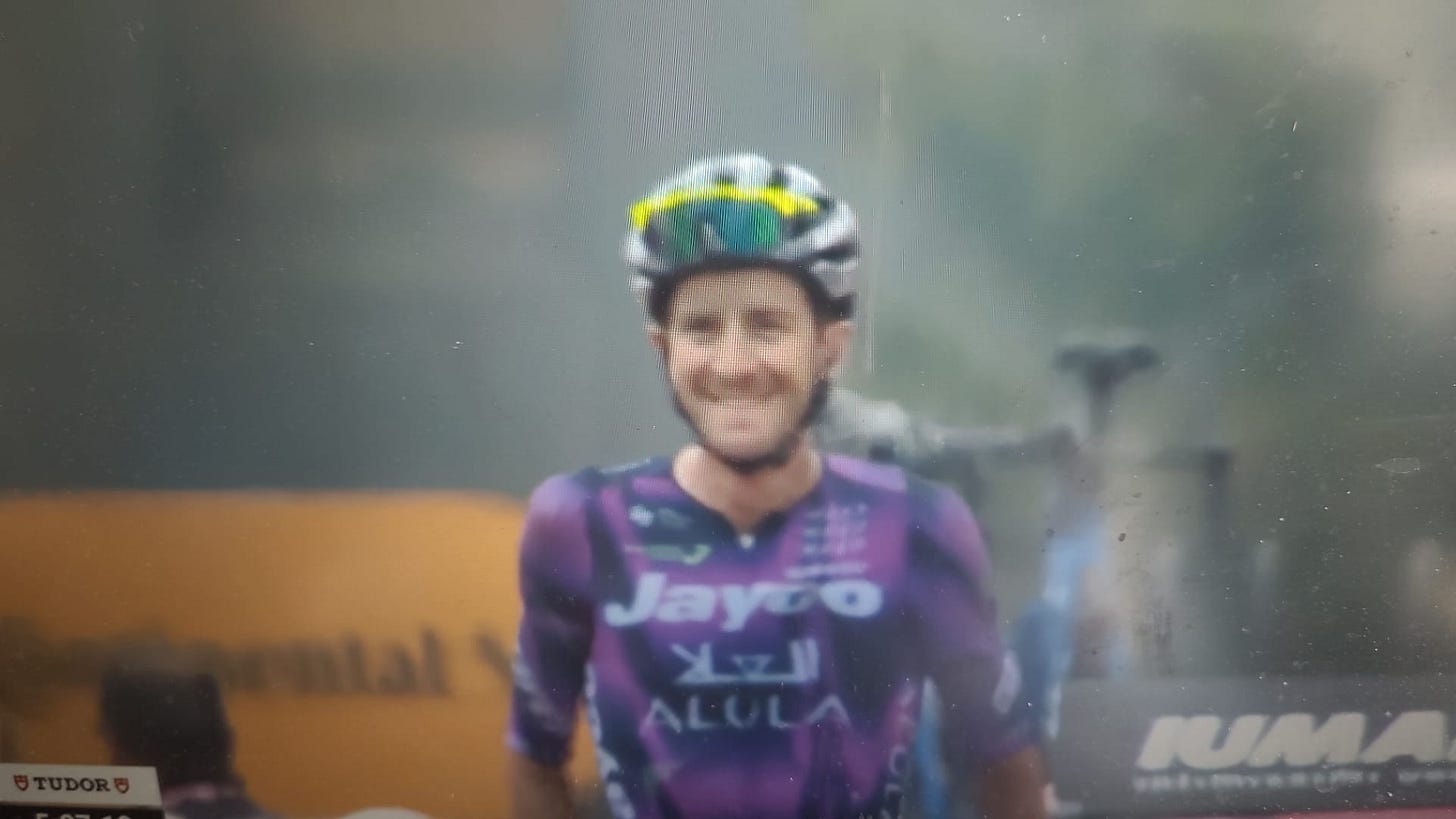
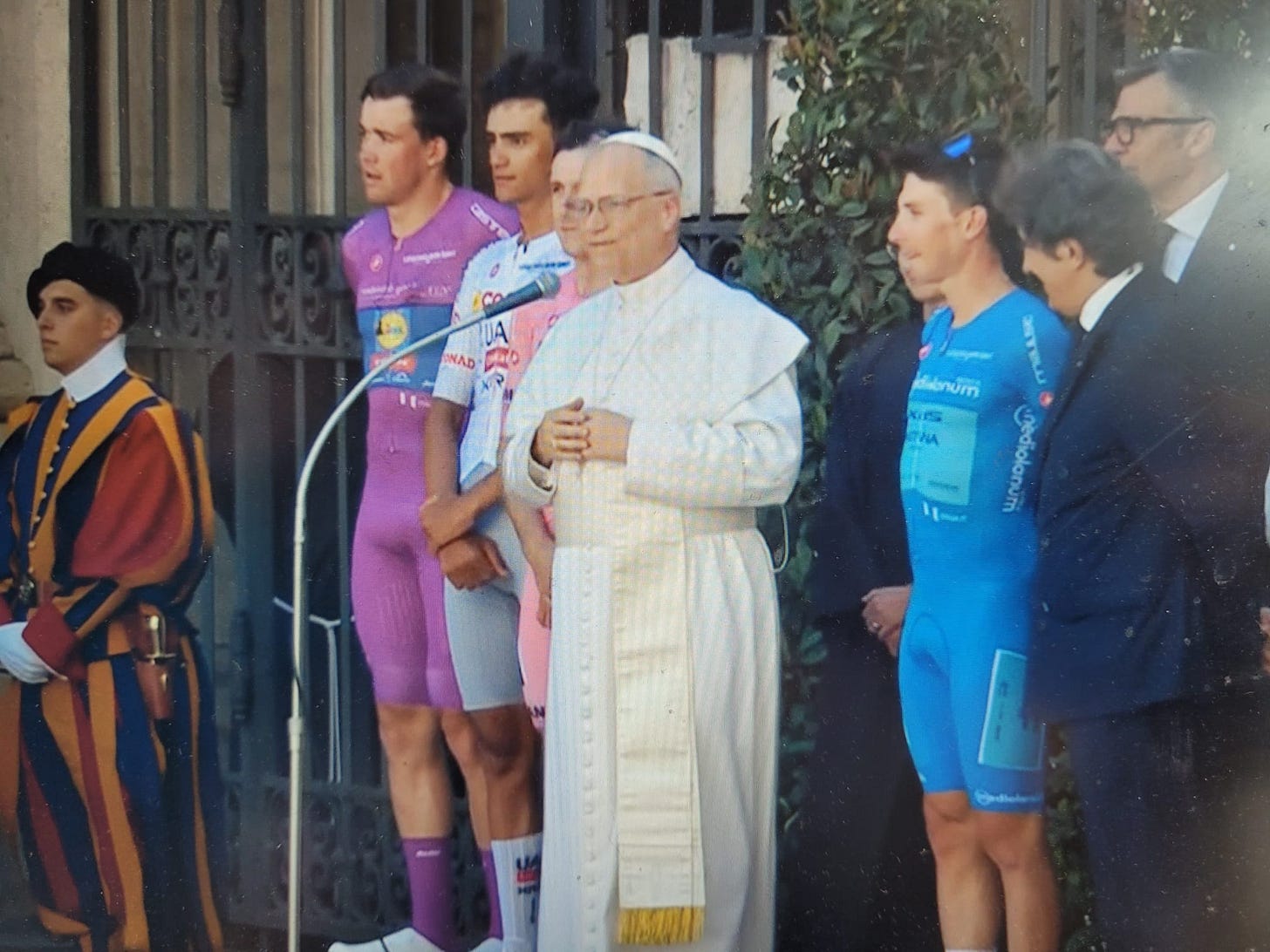
You capture how I think most of us felt watching Stage 20.
And as for missing Stage 19… just remember that the Wout who was so integral to both stages 20 and 21 is the same guy who left the Tour early to be there for the birth of his child. Life comes before sport.
I saw Simon’s attacking on Colle where he had a 20 second lead on del Toro and Carapaz and then fell asleep! I woke up with Simon about 1m40s clear, saw him look over his shoulder at his pursuers and did not know how it had happened.
I also got to the Kelso stage of the Women’s Tour. Stayed awake in the rain to cheer them on.